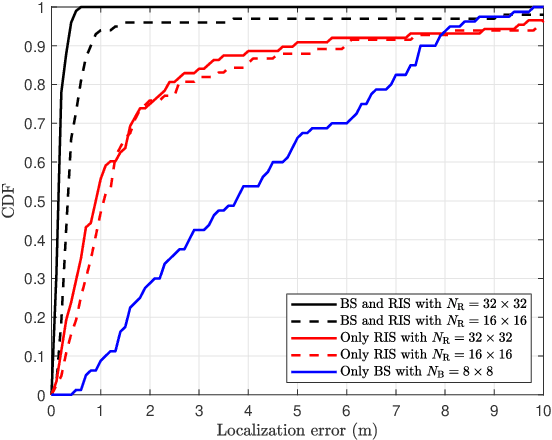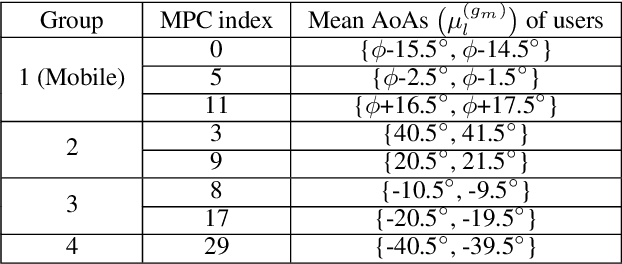Murat Bayraktar
Integrated Monostatic Sensing and Full-Duplex Multiuser Communication for mmWave Systems
May 15, 2024Abstract:In this paper, we propose a hybrid precoding/combining framework for communication-centric integrated sensing and full-duplex (FD) communication operating at mmWave bands. The designed precoders and combiners enable multiuser (MU) FD communication while simultaneously supporting monostatic sensing in a frequency-selective setting. The joint design of precoders and combiners involves the mitigation of self-interference (SI) caused by simultaneous transmission and reception at the FD base station (BS). Additionally, MU interference needs to be handled by the precoder/combiner design. The resulting optimization problem involves non-convex constraints since hybrid analog/digital architectures utilize networks of phase shifters. To solve the proposed problem, we separate the optimization of each precoder/combiner, and design each one of them while fixing the others. The precoders at the FD BS are designed by reformulating the communication and sensing constraints as signal-to-leakage-plus-noise ratio (SLNR) maximization problems that consider SI and MU interference as leakage. Furthermore, we design the frequency-flat analog combiner such that the residual SI at the FD BS is minimized under communication and sensing gain constraints. Finally, we design an interference-aware digital combining stage that separates MU signals and target reflections. The communication performance and sensing results show that the proposed framework efficiently supports both functionalities simultaneously.
The Integrated Sensing and Communication Revolution for 6G: Vision, Techniques, and Applications
May 03, 2024



Abstract:Future wireless networks will integrate sensing, learning and communication to provide new services beyond communication and to become more resilient. Sensors at the network infrastructure, sensors on the user equipment, and the sensing capability of the communication signal itself provide a new source of data that connects the physical and radio frequency environments. A wireless network that harnesses all these sensing data can not only enable additional sensing services, but also become more resilient to channel-dependent effects like blockage and better support adaptation in dynamic environments as networks reconfigure. In this paper, we provide a vision for integrated sensing and communication (ISAC) networks and an overview of how signal processing, optimization and machine learning techniques can be leveraged to make them a reality in the context of 6G. We also include some examples of the performance of several of these strategies when evaluated using a simulation framework based on a combination of ray tracing measurements and mathematical models that mix the digital and physical worlds.
Hybrid Precoding and Combining for mmWave Full-Duplex Joint Radar and Communication Systems under Self-Interference
Nov 25, 2023



Abstract:In the context of integrated sensing and communication (ISAC), a full-duplex (FD) transceiver can operate as a monostatic radar while maintaining communication capabilities. This paper investigates the design of precoders and combiners for a joint radar and communication (JRC) system at mmWave frequencies. The primary goals of the design are to minimize self-interference (SI) caused by FD operation, while guaranteeing certain performance in terms of some sensing and communication metrics, as well as taking into account the hardware limitations coming from a hybrid MIMO architecture. Specifically, we introduce a generalized eigenvalue-based precoder that takes into account downlink user rate, radar gain, and SI suppression. Since the hybrid analog/digital architecture degrades the SI suppression capability of the precoder, we further enhance SI suppression with the analog combiner. Our numerical results demonstrate that the proposed architecture achieves the required radar gain and SI mitigation while incurring a small loss in downlink spectral efficiency. Additionally, the numerical experiments also show that the use of orthogonal frequency division multiplexing (OFDM) for radar processing with the proposed beamforming architecture results in highly accurate range and velocity estimates for detected targets.
Autoregressive Attention Neural Networks for Non-Line-of-Sight User Tracking with Dynamic Metasurface Antennas
Oct 30, 2023Abstract:User localization and tracking in the upcoming generation of wireless networks have the potential to be revolutionized by technologies such as the Dynamic Metasurface Antennas (DMAs). Commonly proposed algorithmic approaches rely on assumptions about relatively dominant Line-of-Sight (LoS) paths, or require pilot transmission sequences whose length is comparable to the number of DMA elements, thus, leading to limited effectiveness and considerable measurement overheads in blocked LoS and dynamic multipath environments. In this paper, we present a two-stage machine-learning-based approach for user tracking, specifically designed for non-LoS multipath settings. A newly proposed attention-based Neural Network (NN) is first trained to map noisy channel responses to potential user positions, regardless of user mobility patterns. This architecture constitutes a modification of the prominent vision transformer, specifically modified for extracting information from high-dimensional frequency response signals. As a second stage, the NN's predictions for the past user positions are passed through a learnable autoregressive model to exploit the time-correlated channel information and obtain the final position predictions. The channel estimation procedure leverages a DMA receive architecture with partially-connected radio frequency chains, which results to reduced numbers of pilots. The numerical evaluation over an outdoor ray-tracing scenario illustrates that despite LoS blockage, this methodology is capable of achieving high position accuracy across various multipath settings.
Multidimensional Orthogonal Matching Pursuit-based RIS-aided Joint Localization and Channel Estimation at mmWave
Mar 24, 2022
Abstract:RIS-aided millimeter wave wireless systems benefit from robustness to blockage and enhanced coverage. In this paper, we study the ability of RIS to also provide enhanced localization capabilities as a by-product of communication. We consider sparse reconstruction algorithms to obtain high resolution channel estimates that are mapped to position information. In RIS-aided mmWave systems, the complexity of sparse recovery becomes a bottleneck, given the large number of elements of the RIS and the large communication arrays. We propose to exploit a multidimensional orthogonal matching pursuit strategy for compressive channel estimation in a RIS-aided millimeter wave system. We show how this algorithm, based on computing the projections on a set of independent dictionaries instead of a single large dictionary, enables high accuracy channel estimation at reduced complexity. We also combine this strategy with a localization approach which does not rely on the absolute time of arrival of the LoS path. Localization results in a realistic 3D indoor scenario show that RIS-aided wireless system can also benefit from a significant improvement in localization accuracy.
An Efficient Interference-Aware Constrained Massive MIMO Beamforming for mm-Wave JSDM
Mar 22, 2021



Abstract:Low-complexity beamformer design with practical constraints is an attractive research area for hybrid analog/digital systems in mm-wave massive multiple-input multiple-output (MIMO). This paper investigates interference-aware pre-beamformer (analog beamformer) design for joint spatial division and multiplexing (JSDM) which is a user-grouping based two-stage beamforming method. Single-carrier frequency domain equalization (SC-FDE) is employed in uplink frequency-selective channels. First, unconstrained slowly changing statistical analog beamformer of each group, namely, generalized eigenbeamformer (GEB) which has strong interference suppression capability is designed where the mutual information in reduced dimension is maximized. Then, constant-modulus constrained approximations of unconstrained beamformer are obtained by utilizing alternating minimization algorithms for fully connected arrays and fixed subarrays. In addition, a dynamic subarray algorithm is proposed where the connections between radio frequency (RF) chains and antennas are changed with changing channel statistics. Convergence of the proposed alternating minimization-based algorithms are provided along with their complexity analysis. It is observed that additional complexity of proposed algorithms is insignificant for the overall system design. Although most of the interference is suppressed with the help of proposed constrained beamformers, there may be some residual interference after the analog beamforming stage. Therefore, linear minimum mean square error (LMMSE) type digital beamformers, which take the residual interference in reduced dimension into account, are proposed instead of zero-forcing (ZF) type. Simulation results verify the superiority of the proposed interference-aware constrained design over existing approaches in terms of beampattern, spectral efficiency, outage capacity and channel estimation accuracy.
 Add to Chrome
Add to Chrome Add to Firefox
Add to Firefox Add to Edge
Add to Edge